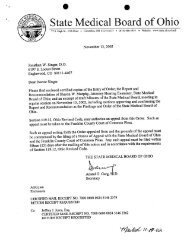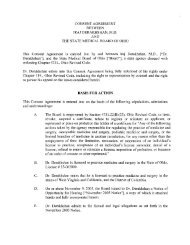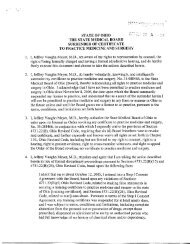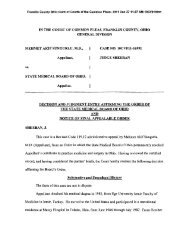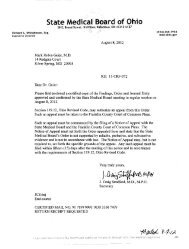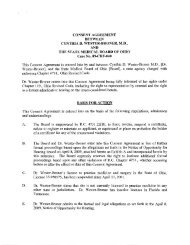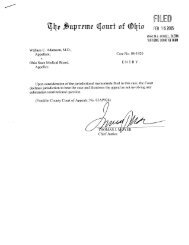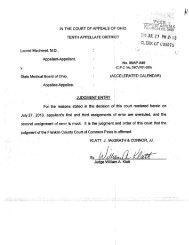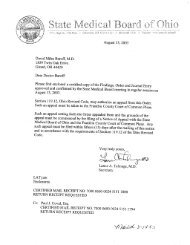CONSENT AGREEMENT BETWEEN - State Medical Board of Ohio ...
CONSENT AGREEMENT BETWEEN - State Medical Board of Ohio ...
CONSENT AGREEMENT BETWEEN - State Medical Board of Ohio ...
Create successful ePaper yourself
Turn your PDF publications into a flip-book with our unique Google optimized e-Paper software.
Matter <strong>of</strong> Kyle Elliott Hoogendoorn, D.P.M. Page 42<br />
One, it was a fantastic opportunity for myself. Podiatry has always struggled<br />
to be accepted amongst M.D.s and D.O.s, and I worked with a lot <strong>of</strong> M.D.s<br />
while I was at the program and gained their confidence and worked with them<br />
very closely. So it kind <strong>of</strong> was exciting to be brought into that.<br />
Also, there’s a lot <strong>of</strong> things that they’ve done or currently still do that they<br />
may do in the low back; but I’ve also taken it now and do it down in the foot<br />
and ankle, which has proved to be very successful. The training was at that<br />
point one <strong>of</strong> a kind, so to speak; and I thought it was an excellent opportunity<br />
to increase my base knowledge <strong>of</strong> pain and expand on it in the private practice<br />
within the podiatric scope.<br />
(Tr. at 2209-2210)<br />
103. Dr. Hoogendoorn testified that, after he entered the PCC program, he had sought and<br />
obtained accreditation for the program from the Council on Podiatric <strong>Medical</strong> Education<br />
[CPME]. Dr. Hoogendoorn further testified that CPME accreditation had required linking<br />
the program with the <strong>Ohio</strong> College <strong>of</strong> Podiatric Medicine. PCC and the OCPM entered<br />
into an agreement to that effect, dated September 13, 2001. (Resp. Ex. 119H;<br />
Tr. at 2218-2221)<br />
By letter dated January 8, 2002, the CPME notified Dr. Leak that, effective January 1,<br />
2002, the PCC fellowship program had been granted approval as a podiatric fellowship in<br />
pain management. (Resp. Ex. 121H)<br />
104. Dr. Hoogendoorn testified that the CPME would not recognize or give credit for the time<br />
he had spent in the fellowship prior to January 8, 2002. Therefore, he repeated that time<br />
and remained in the fellowship until September 2003. (Tr. at 2222-2224, 2535)<br />
105. Dr. Hoogendoorn testified that there had been no difference in the training he received<br />
at the PCC fellowship between the times prior to and after CPME accreditation.<br />
(Tr. at 2224)<br />
106. Dr. Hoogendoorn described at length his responsibilities during the fellowship and his<br />
purpose in participating in the fellowship:<br />
This was harder than my residency. You were required to have self-directed<br />
learning on top <strong>of</strong> directed learning. You were to evaluate as many patients as<br />
you can in clinic and present them to the attending and then the attending<br />
would ask you questions and then you would be given direction to look up<br />
new educational information or techniques or other things.<br />
You would have to know pharmacology. You’d have to know nerve blocks,<br />
nerve roots, dermatomes, sclerotomes, why certain medications work and why<br />
some don’t, some drug interactions. You would have to do research on topics.



